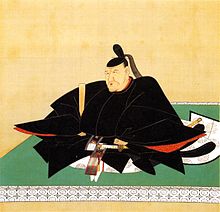Tokugawa Ieshige
| Tokugawa Ieshige | |
|---|---|
 |
|
| 9th Edo Shogun | |
|
In office 1745–1760 |
|
| Preceded by | Tokugawa Yoshimune |
| Succeeded by | Tokugawa Ieharu |
| Personal details | |
| Born | January 28, 1712 |
| Died | July 13, 1761 (aged 49) |
Tokugawa Ieshige; 徳川 家重 (January 28, 1712 – July 13, 1761) was the ninth shogun of the Tokugawa shogunate of Japan.
The first son of Tokugawa Yoshimune, his mother was the daughter of Ōkubo Tadanao, known as Osuma no kata. His mother died in 1713 when he was only 2 years old, so he was raised by Yoshimune's concubine, Okon no Kata but later Okon give birth to Tokugawa Munetake so he was raised by Yoshimune's another concubine, Okume no Kata as her biological son.
His childhood name was Nagatomi-maru. He underwent the genpuku coming-of-age ceremony in 1725. His first wife, Nami-no-miya, was the daughter of Prince Fushimi-no-miya Kuninaga (伏見宮 邦永親王). His second wife, Okō, was the daughter of one of the courtiers who had followed his high-born first wife from the Imperial Court to the Shogunal Court in Edo. This famously good-natured second wife was the mother of Ieharu, who would become Ieshige's heir.
In 16th April 1731, he married Nami-no-Miya Masuko, daughter of Fushimi no Miya Kuninaga Shinno.
In 1733, Nami-no-Miya Masuko miscarriage and die.
In Enkyō 2 or 1745, Ieshige was made shogun.
Ieshige suffered from chronic ill health and a severe speech defect. Yoshimune's choice of Ieshige as his heir created considerable controversy within the shogunate as his younger brothers Tokugawa Munetake and Tokugawa Munetada appeared to be far more suitable candidates. Yoshimune continued to insist on his decision, favoring the Confucian principle of primogeniture; and Ieshige continued in the role of formal head of the shogunate. Yoshimune directed affairs after his official retirement in 1745. This attention was designed to ensure that Ieshige was secure in his office. Ieshige remained shogun until 1760.
Uninterested in government affairs, Ieshige left all decisions in the hands of his chamberlain, Ōoka Tadamitsu (1709–1760). He officially retired in 1760 and assumed the title of Ōgosho, appointed his first son Tokugawa Ieharu as the 10th shogun, and died the following year.
...
Wikipedia
